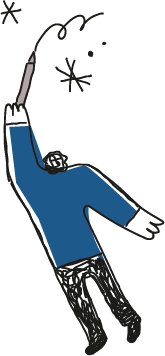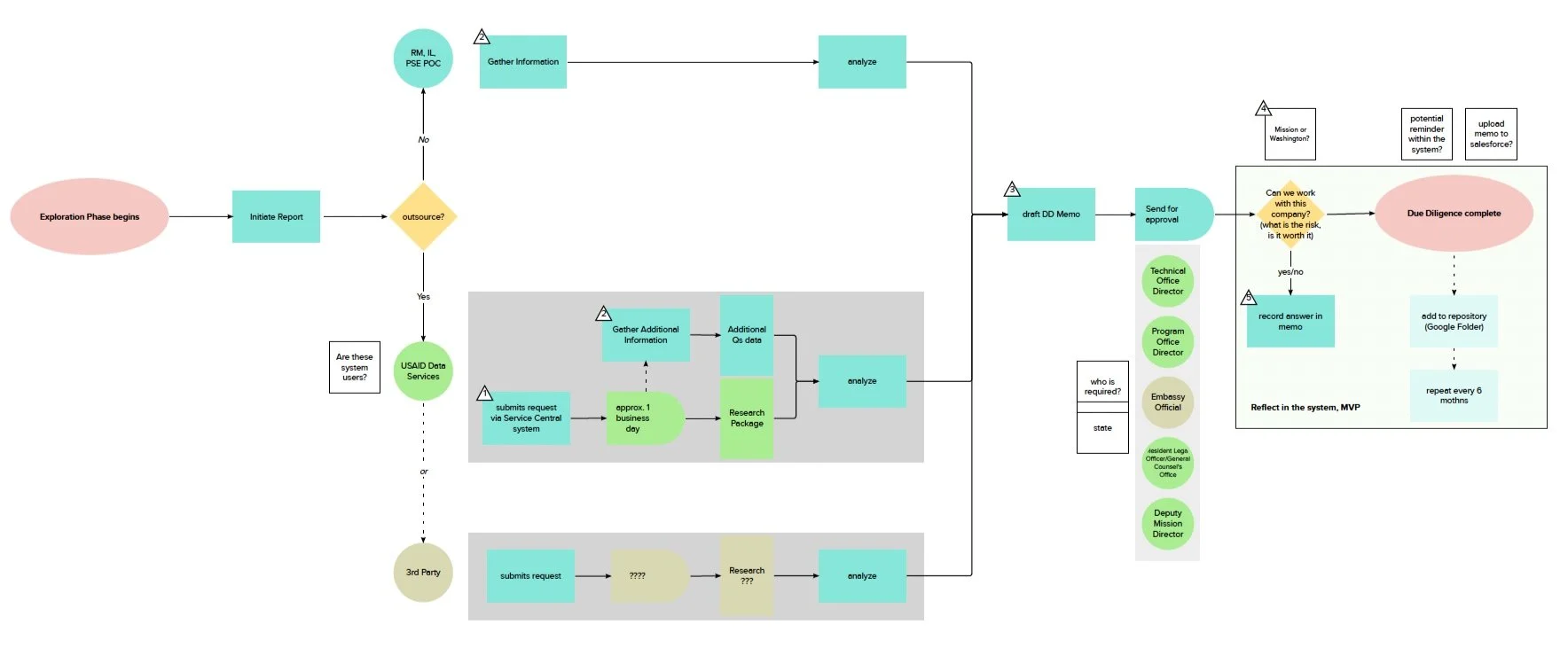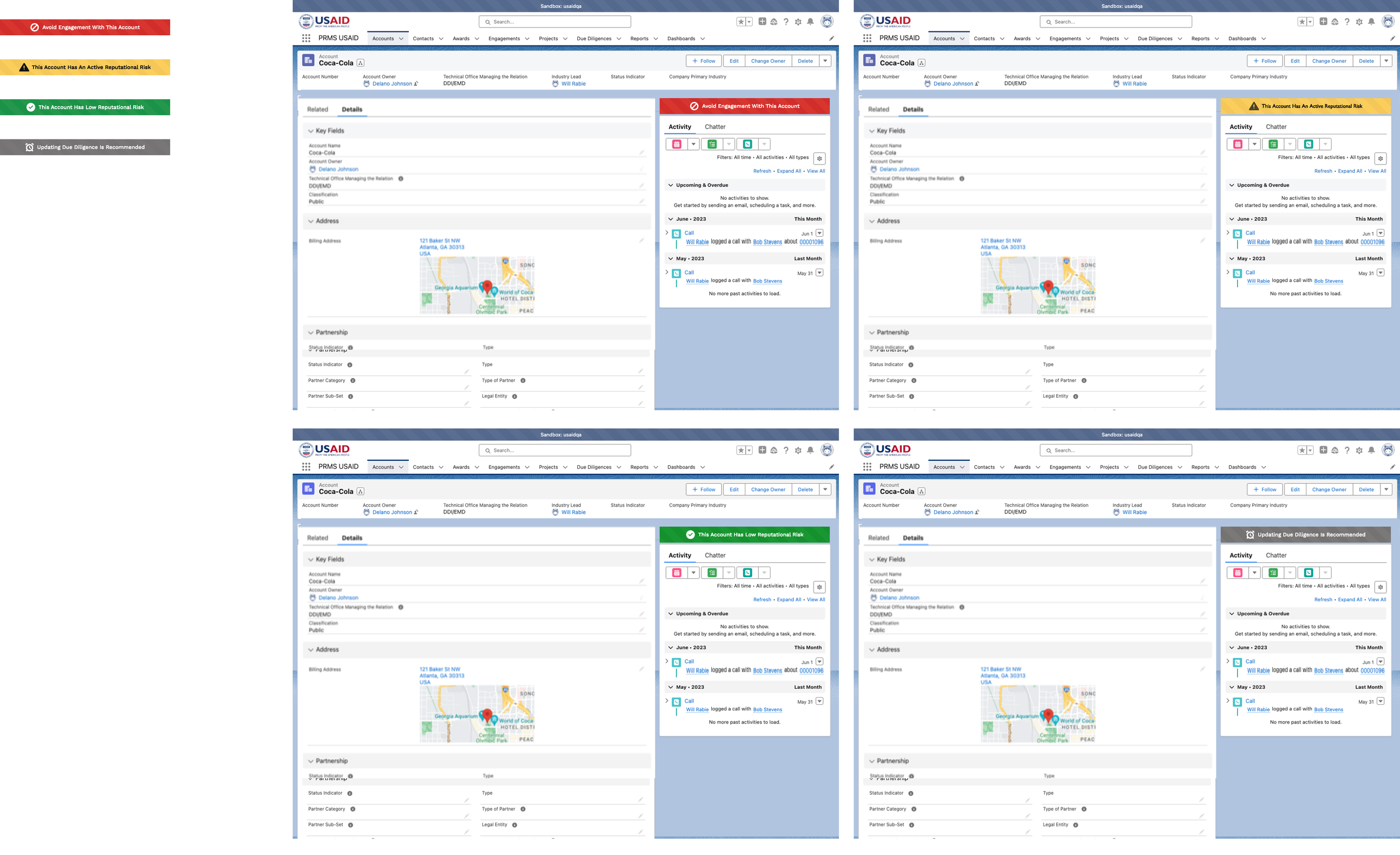A HOLISTIC VIEW OF USAID
A design strategist’s approach to solutioning for a Government client
This is an in-progress contract with Steampunk, Inc., and this internship case study will be updated incrementally.
Team
Tools
Timeline
Design & Strategy Intern (Junior Service Designer), Senior Service Designer, UX Designer, Disruption Designer, Functional Analyst, and more.
Figma, LucidChart, Mural, Jira/Confluence, InDesign & Illustrator.
April, 2023 - Present
OVERVIEW
THE PROJECT
I am a Design & Strategy Intern at Steampunk, Inc., working directly with two other designers on a contract with USAID. Steampunk was hired to build a customer relationship management (CRM) system for USAID employees who engage with the Private Sector.
As an intern, I helped untangle USAIDs complex problems, harnessing human-centered design and the design thinking process to understand its people, systems, and data to improve the employee experience.
MY ROLE + IMPACT
Harnessing my visual and strategic design background, I participated in and even led key design initiatives to assist with building a Salesforce CRM for USAID; these initiatives include:
Defining
Assisting in Interviews and leading Affinity Mapping to synthesize findings.
Concept Mapping, Eco-system Mapping, and creating Process Flows to understand USAID data, people, systems, and processes.
Shaping
Designing Salesforce components and working with Developers to build correctly.
Creating and facilitating Client Norming and AUG Intro Sessions (Advisory User Group), and leading post-workshop synthesis.
How is this being accomplished?
PROBLEM STATEMENT
USAID’s work with the private sector encourages inclusive growth and a more significant global development impact.
However, a lack of a shared system or defined process has created a roadblock to consistent and effective relationship management between USAID staff and the private sector.
Working closely with the cross-functional Steampunk team, I have been helping inform CRM design decisions to address these specific challenges and enhance the overall effectiveness of staff engagement in the private sector.
DISCOVERY
The interviews were aimed at understanding:
USAID mission objectives and relationships with external partners
Pain points and successes of current processes
Relationships and workflows of USAID HQ (DC) and Operating Units and Missions abroad.
The affinity map helped me and the Design & Strategy team build five detailed User Personas, which the business team still uses for creating and defining user stories to develop Salesforce features, and the Disruption designer (Change Management) uses to determine potential barriers to adoption.
I analyzed 32 interviews with USAID staff from HQ and 14 different missions and operating units worldwide, creating an affinity map from comments, insights, and pain points to identify patterns and themes. Below is a snapshot of the affinity map.
INTERVIEWS & AFFINITY MAPPING
The Lead Service Designer, UX Designer, and I conducted an initial discovery effort to comprehensively understand the agency's expectations and requirements for the planned CRM, starting with individual and group interviews.
Objectives
CONCEPT MAPPING & PROCESS FLOWS
From this process flow, I helped determine that Due Diligence should be included as a Salesforce object for the Minimum Viable Product (MVP). Working directly with Steampunk's Functional Analyst and Senior Service Designer, I identified the business value to help develop a user story and technical solution for efficiently handling Due Diligence in the system.
ECO-SYSTEM MAP OF USAID’S DATABASES
Through interviews and interactions with the client, the Steampunk team discovered a complex network of systems and databases within USAID. To leverage USAID's existing data and understand which database was needed to integrate with the ECRM, I worked closely with Steampunk's data architect to identify databases suitable for integration by building the eco-system map below to understand the connections, data gaps, and uses.
A Work in Progress
The map became a client deliverable when they realized the business value it would bring.
The map prompted more questions for the USAID team written throughout the map.
Next steps included finding the overlap of system functions and how each persona uses each system.
A Holistic Approach
I focused on understanding three USAID concepts; Contributions and Awards, Due Diligence, and USAID databases. I approached the concepts from a birds-eye-view to align behaviors and relationships and translate insights into user stories with the development team.
A CONCEPT MAP OF USAID’S CONTRIBUTIONS & AWARDS
Below is a concept map I put together from USAID's existing data architecture combining funding tools, awards, and contributions and how they related to any mention of the USAID PSE partnership lifecycle.
I wanted to determine if and how funding and dollar amounts would translate into the development and design decisions we had already made for the ECRM.
Insights
Completing this map helped me understand how USAID defines its financial contributions, which allowed me to help make informed business decisions about creating user stories with the Senior Service Designer, Functional Analyst, and Technical Architect.
A PROCESS FLOW & COMPLEXITY MAP OF DUE DILIGENCE
Due Diligence is USAID's process of confirming if a partner organization has any reputational risk. It is standard for every USAID employee engaging in a partnership to complete Due Diligence, so understanding the process, its complexity, and its importance to the system users was the motivation behind the flow below.
DISCOVERY IN A NUTSHELL
Working with the Design & Strategy team during this phase of the contract has been a fantastic experience, and collaborating with different types of people in different roles has taught me how to advocate and explain the
holistic service design approach and how it benefits technical analysts, data architects, developers, and most importantly, the client.
Design & Workshopping
In addition to gathering the complete picture of USAID, I have also been able to design some solutions and stepping stones needed to implement a successful ECRM. This includes custom Salesforce components for Due Diligence and creating and facilitating an engaging workshop improving Steampunk and Client communication and alignment.
CUSTOM SALESFORCE COMPONENTS
The Design & Strategy, Business, and Technical teams crafted a solution for including Due Diligence in MVP that required designing custom Salesforce components. The components would be integrated into Account pages, providing users real-time risk status updates.
I created user-friendly and accessible custom components and worked with the developers to bring them to life in Salesforce. The components and mockups are below.
User Personas and
Mind-Mapping
The Change Management reviewed the personas the Design & Strategy team put together, then used Mind-Mapping to put themselves in the user's shoes.
CHANGE MANAGEMENT DEEP DIVE
Identifying a recurring communication challenge with the Change Management team and USAID client, I proactively organized a workshop that involved a few exercises to encourage strategic alignment.
Initially, the client was skeptical and slow to engage with the workshop. Noticing this, we worked together to ensure they understood the benefits of each exercise and skipped bits and pieces that felt less relevant to their team. Ultimately, The workshop facilitated improved understanding, collaboration, and strategy alignment, leading to more effective change implementation and communication.
Co-Creation
The client and Steampunk Change Management teams, collaboratively mapped out and ideated a strategic plan based on the existing pilot model rollout.
Grouping Exercise
This exercise was meant to connect the user personas to previously identified Change Management strategy buckets.
CONCLUSION
To learn more about USAID’s efforts in modernizing foreign assistance through private sector engagement, click here.
To learn more about Steampunk, click here.















